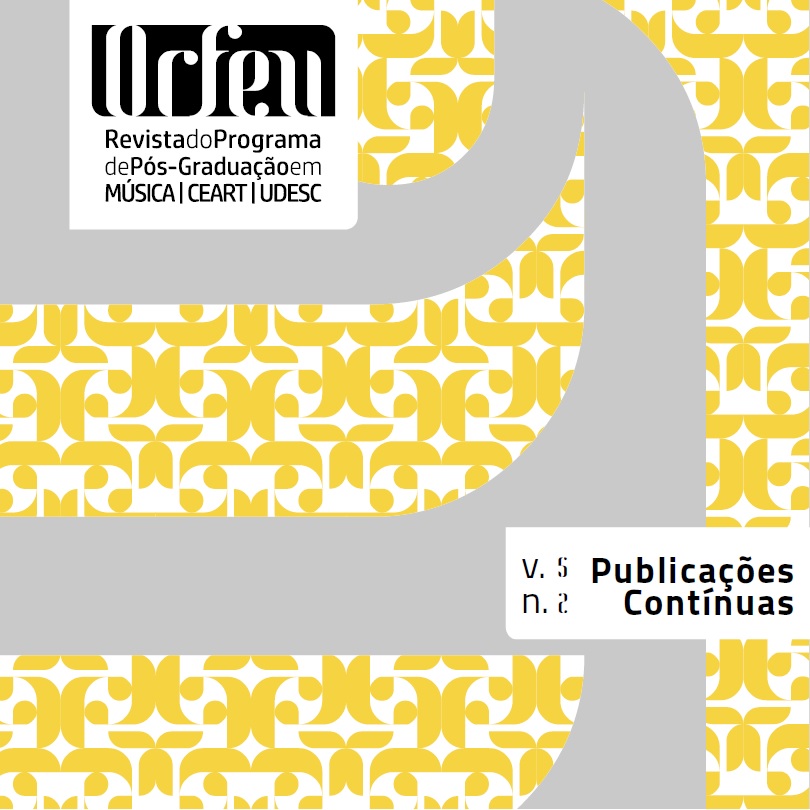Three field recordings in the city of Rio de Janeiro
DOI:
https://doi.org/10.5965/2525530405022020e0005Keywords:
Field recording, negative spaces, opaque spaces, listening, urban walksAbstract
This paper presents three walks whose intention were either the listening of a region of Rio de Janeiro as well as its photographic and phonographic takings, therefore making a poetic analysis of the material. In order to support the analysis, a bibliographic revision relating concepts from urban mobility and listening is made. Taking the thesis of Steven Feld (2015) as starting point, in which the sound is understood as an object for the social tissue’s knowledge, the sonority of the visited places is taken as focus for the discussion. Those places can be understood, by their urban characteristics in the context of the contemporary city, as negative spaces (Milton Santos, 1994) or opaque spaces(Francesco Careri, 2017) – and those concepts will have significant repercussions on the incursions´s narratives. The obtained material intends to interrelate the textual and photographic registers with the sounded register in order to contextualize its listening. In spite of one of the incursions has resulted on a sound installation, the material is previous any artistic realization in a work format and either its analysis as its listening are part of a current compositional process or, at least, of a sound/musical creation from field recordings.
Downloads
References
BANDEIRA, M. Poesia completa e prosa. Rio de Janeiro: Nova Aguilar, 1993 [1944].
BERENSTEIN, P. Elogio aos errantes. Salvador: Ud. UFBA, 2014.
CARERI, F. Walkscapes: o caminhar como prática estética. São Paulo: Gustavo Gili, 2013.
CARERI, F. Caminhar e parar. São Paulo: Gustavo Gili, 2017.
CAUX, J.; FERRARI, L. Presque Rien avec Luc Ferrari. Paris: Main d’Oeuvre, 2002.
DROTT, E. The Politics of Presque Rien. In: ADLINGTON, R. Sound commitments: avant-garde and the sixties. New York: Oxford University Press, 2009.
FELD, S. Acoustemology. In: NOVAK, D.; SAKAKEENY, M. Keyword in sound. Durham: Duke University Press, 2015.
FENERICH, A. S. A inscrição da intimidade na Symphonie pour un Homme Seul. Tese (Doutorado em Artes) – USP, São Paulo, 2012.
FENERICH, A. S. Wanderings through the aterro do mangue of Rio de Janeiro. In: BREITSAMETER, S.; KARAKIZ, C. The Global Composition 2018: conference on sound, ecology and media culture – proceedings. Dieburg: Hochschule Darmstadt, 2018.
FOSTER, H. O retorno do real. São Paulo: Cosac Naify, 2014.
GILKEY, R.; ANDERSON, T. Binaural and spatial hearing in real and virtual environments. New York: Psychology Press, 2014.
GUTIERREZ, A. Flâneuse>La caminanta. In: BREITSAMETER, S.; KARAKIZ, C. The global
composition 2018: conference on sound, ecology and media culture – proceedings. Dieburg: Hochschule Darmstadt, 2018.
KIM-COHEN, Seth. In the blink of an ear: toward an non-cochlear sound art. New York: Continuum, 2009.
LA BURTHE, A. The immersive power of binaural sound: an interwiew with Amaury La Burthe. [Entrevista cedida a] Benjamin Huguet. CMF Trends, 25 jan. 2017. Disponível em: https://trends.cmf-fmc.ca/the-immersive-power-of-binaural-sound-an-interview-with-amaury-la-burthe-audiogaming/. Acesso em: 23 jun. 2020.
NANCY, J. Listening. New York: Fordham University Press, 2007.
SANTOS, M. Técnica espaço tempo: globalização e meio técnico-científico informacional. São Paulo: Hucitec, 1994.
SANTOS, M. Elogio da lentidão. Folha de S.Paulo, São Paulo, 11 mar. 2001.
SCHAEFFER, P. À la recherche d’une musique concrète. Paris: Éditions du Seuil, 1952.
SCHAUB, M.; CARDIFF, J. Janet Cardiff: the walk book. Viena: Thyssen-Bornemisza Art Contemporary, 2005.
SMALLEY, D. La Spectromorphologie. Une explication des formes du son. Ars Sonora, n. 8, p. 64-114, 1999.
WESTERKAMP. H. Soundwalking as Ecological Practice. Hildegard Westerkamp, 3 nov. 2006. Disponível em: http://www.hildegardwesterkamp.ca/writings/writingsby/?post_id=14&title=%E2%80%8Bsoundwalkin g-as-ecological-practice. Acesso em: 20 fev. 2019.
Downloads
Published
How to Cite
Issue
Section
License
Copyright (c) 2020 ORFEU

This work is licensed under a Creative Commons Attribution 4.0 International License.
Authors who submit their manuscripts to be published in this journal agree to the following terms:
1. Authors retain the copyright and grant to the journal the right of first publication, whilst simultaneously permitting their work to be licensed under the Creative Commons License Attribution, which allows the sharing of work with recognition of the authorship and initial publication in this journal.
2. Contributions in this journal are open access; this means they are based in free use, and non-commercial applications.






